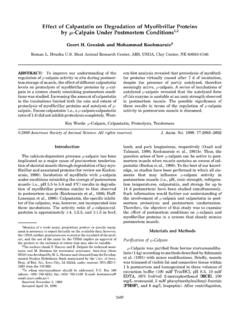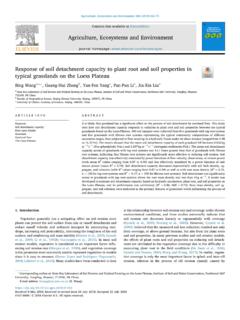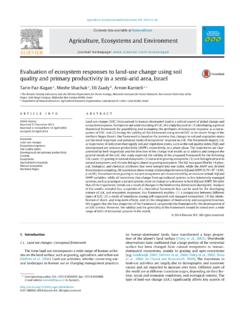Transcription of Agriculture, Ecosystems and Environment - ars.usda.gov
1 agriculture , Ecosystems and Environment 247 (2017) 283 289. Contents lists available at ScienceDirect agriculture , Ecosystems and Environment journal homepage: Multitrophic Cry-protein ow in a dual-gene Bt-cotton eld MARK. a a b a, . Michael Eisenring , J rg Romeis , Steven E. Naranjo , Michael Meissle a Agroscope, Research Division Agroecology and Environment , Reckenholzstrasse 191, 8046, Zurich, Switzerland b usda -ARS, Arid-Land Agricultural Research Center, 21881 N. Cardon Lane, Maricopa, AZ 85138, USA. A R T I C L E I N F O A B S T R A C T. Keywords: The transfer of plant-produced insecticidal Cry-proteins in the arthropod food web can be a ected by a number Arthropod food web of environmental and ecological factors.
2 Despite this fact, most studies documenting multitrophic Cry-protein Bacillus thuringiensis acquisition patterns in arthropods are conducted under controlled conditions whereas the number of eld studies Bollgard II is limited. Such eld studies, however, are valuable to understand multitrophic allocation dynamics of Cry- Bt-cotton proteins under ecologically realistic conditions and are therefore important for the interpretation and design of Environmental risk assessment laboratory hazard studies on genetically engineered (GE) crops. We thus sampled arthropods and plant struc- Genetically modi ed crops tures in a eld planted with GE dual-gene cotton plants producing the Cry-proteins Cry1Ac and Cry2Ab from Bacillus thuringiensis Berliner over the growing season.
3 Cry-protein concentrations in eld-collected plants, herbivores, and predators were quanti ed and compared with arthropods subjected to tri-trophic laboratory feeding assays. Both, eld studies and laboratory assays showed that Cry-protein concentrations strongly de- creased with increasing trophic level to values mostly below the detection limit in predators. Under eld con- ditions, in-planta Cry-protein concentrations varied between plant structures and over the season. Concentrations in arthropods were mainly associated with feeding mode, feeding location on the plant, and to a lesser degree seasonality.
4 Compared to plants, arthropods showed lower Cry2Ab:Cry1Ac ratios indicating that Cry2Ab might be less stable than Cry1Ac. Of all predators collected in the eld study, we measured highest Cry-protein levels in jumping and crab spiders, predatory ies and some predatory hemipterans. This emphasizes the relevance of these groups for the risk assessment of GE cotton. 1. Introduction conditions. More realistic studies, such as semi- eld or eld studies, may then be conducted with Bt-transgenic plant material if the risk of Cotton (Gossypium spp.) is cultivated on about 30 million hectares adverse e ects cannot be excluded from the worst-case studies (Romeis worldwide ( usda , 2017), and harbors a species-rich complex of ar- et al.)
5 , 2008). Hazard assessments are conducted for selected surrogate thropods (King et al., 1996). About 75% of the globally cultivated species that represent important taxonomic and functional groups for cotton is genetically engineered (GE) and produces Cry-proteins from the particular Bt-crop under consideration (Romeis et al., 2013). De- Bacillus thuringiensis Berliner ( Bt-cotton ), which protect the plant tailed information on the movement of Cry-proteins in the arthropod against certain lepidopteran pests. An increasing number of Bt-cotton food web would support the selection of relevant surrogate species for plants produce two Cry-proteins, Cry1Ac and Cry2Ab (ISAAA, 2016) laboratory testing.
6 With di erent in-planta expression rates (Su et al., 2015) and slightly The multitrophic transfer of Cry-proteins in the eld depends on a di erent target spectra within the Lepidoptera (Sivasupramaniam et al., variety of factors. In-planta Cry-protein levels under eld conditions 2008). di er among plant structures and are a ected by seasonal and en- Because Bt-cotton interacts with a multitude of arthropods, a major vironmental factors (Greenplate, 1999; Adamczyk and Sumerford, concern is that the produced insecticidal Cry-proteins might harm non- 2001; Kranthi et al., 2005; Knight et al.)
7 , 2013). Concentrations of Cry- target species, particularly bene cial arthropods such as natural ene- proteins in predators might largely depend on the availability of prey mies, pollinators, and decomposers. This potential risk is thus assessed and can thus be in uenced by seasonal prey-population dynamics prior to the release of any GE plant. A non-target species will only be at (Kendall et al., 1999). Furthermore, herbivores and predators might risk if it is exposed to a Cry-protein at hazardous concentrations. Hazard contain di erent Cry-protein concentrations depending on their mode is usually assessed in laboratory assays under worst-case exposure of feeding, their feeding location on the plant, the rate of food uptake.
8 Corresponding author. E-mail address: (M. Meissle). Received 2 March 2017; Received in revised form 5 July 2017; Accepted 6 July 2017. 0167-8809/ 2017 Elsevier All rights reserved. M. Eisenring et al. agriculture , Ecosystems and Environment 247 (2017) 283 289. and excretion, their behavior and possibly also the physiology of the Spodoptera exigua (H bner) (Lepidoptera: Noctuidae) caterpillars digestive system (Romeis et al., 2009). Finally, studies under controlled (Frontier Agricultural Sciences, Newmark, USA) were fed for at least conditions found that some Cry-proteins might degrade quicker than 24 h on foliage of Bt-cotton branches collected in the eld.
9 Although S. others, leading to changing ratios of di erent Cry-proteins produced by exigua is an unlikely prey species to be found in a Bt-cotton ecosystem the plant within increasing trophic levels (Tian et al., 2013; Su et al., in Arizona, they depict a good prey-model organism for multitrophic 2015; Meissle and Romeis, 2017). laboratory feeding studies due to their Cry-protein tolerance and rela- Most exposure studies with Bt-cotton have been conducted under tively high Cry-protein content when fed on Bt-cotton. For the bioassay, controlled laboratory or greenhouse conditions and encompassed few predators were kept individually in ventilated Petri dishes ( cm common species (Zhang et al.))
10 , 2006; Torres and Ruberson, 2008; diameter) and were o ered 5 7 caterpillars (2nd 3rd instar) between Meissle and Romeis, 2017). Field studies, on the other hand, which 08:00 09:30 in the morning and again between 16:00 17:30 in the document Cry-protein allocation patterns within realistic cotton food afternoon. At each feeding event, the remaining uneaten caterpillars webs are limited (but see Torres et al., 2006), and are even completely were removed. Observations con rmed that all predatory species were lacking for dual-gene cotton. The goals of the current study were able to feed on the caterpillars.



















